PONTIAC GRAND-PRIX 1993 Owners Manual
Manufacturer: PONTIAC, Model Year: 1993, Model line: GRAND-PRIX, Model: PONTIAC GRAND-PRIX 1993Pages: 338, PDF Size: 17.3 MB
Page 141 of 338
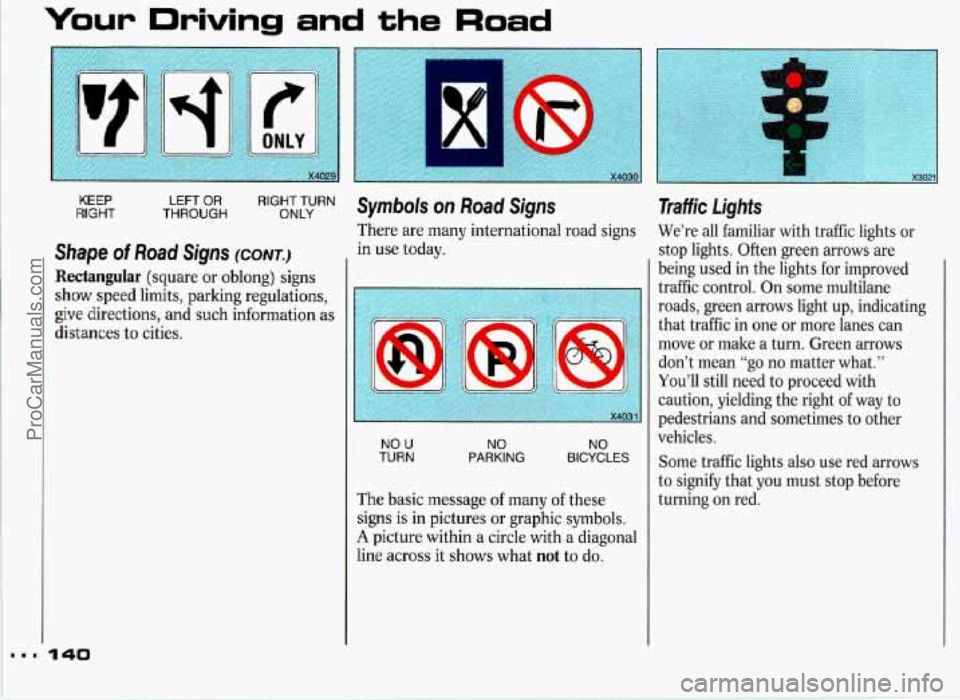
Your Driving and the Road
I X
KEEP RIGHT LEFT OR THROUGH RIGHT TURN ONLY
Rectangular (square or oblong) signs
show speed limits, parking regulations,
give directions, and such information as
distances to cities.
Symbols on Road Signs
There are many international road signs
in use today.
NO u TURN NO PARKING NO
BICYCLES
The basic message of many of these
signs is in pictures or graphic symbols.
A picture within a circle with a diagonal
line across it shows what
not to do.
Traffic Lights
We’re all familiar with traffic lights or
stop lights. Often
green arrows are
being used in the lights for improved
traffic control. On some multilane
roads, green arrows light
up, indicating
that traffic in one
or more lanes can
move or make a turn. Green arrows
don’t mean
“go no matter what.”
You’ll still need to proceed with
caution, yielding the right
of way to
pedestrians and sometimes to other
vehicles.
Some traffic lights
also use red arrows
to signify that
you must stop before
turning on red.
ProCarManuals.com
Page 142 of 338
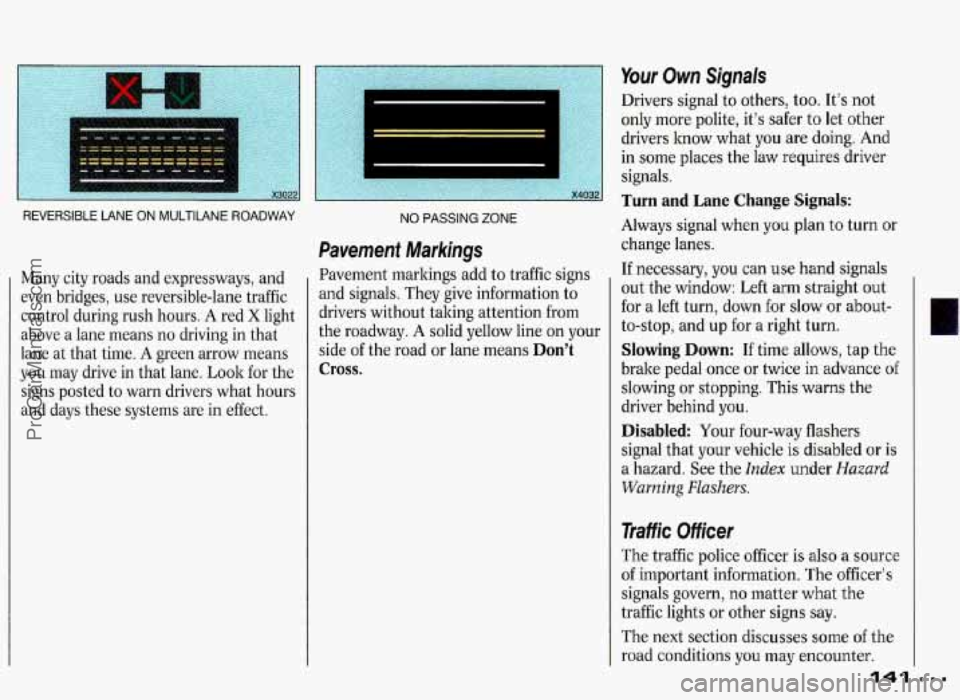
REVERSIBLE LANE ON MULTILANE ROADWAY
Many city roads and expressways, and
even bridges, use reversible-lane traffic
control during rush hours. A red
X light
above a lane means
no driving in that
lane at that time.
A green arrow means
you may drive in that lane. Look for the
signs posted to warn drivers what hours
and days these systems are in effect.
I
I
NO PASSING ZONE
Pavement Markings
Pavement markings add to traffic signs
and signals. They give information to
drivers without taking attention from
the roadway. A solid yellow line on your
side
of the road or lane means Don’t
Cross.
Your Own Signals
Drivers signal to others, too. It’s not
only more polite,
it’s safer to let other
drivers know what you are doing.
And
in some places the law requires driver
signals.
Turn and Lane Change Signals:
Always signal when you plan to turn or
change lanes.
If necessary, you can use hand signals
out the window: Left arm straight out
for a left turn,
down for slow or about-
to-stop, and up for a right turn.
Slowing Down: If time allows, tap the
brake pedal once or twice in advance
of
slowing or stopping. This warns the
driver behind you.
Disabled: Your four-way flashers
signal that your vehicle
is disabled or is
a hazard. See the
Index under Hazard
Warning Flashers.
Traffic Officer
The traffic police officer is also a source
of important information. The officer’s
signals govern, no matter what the
traffic lights
or other signs say.
The next section discusses some of the
road conditions you
may encounter.
141
ProCarManuals.com
Page 143 of 338
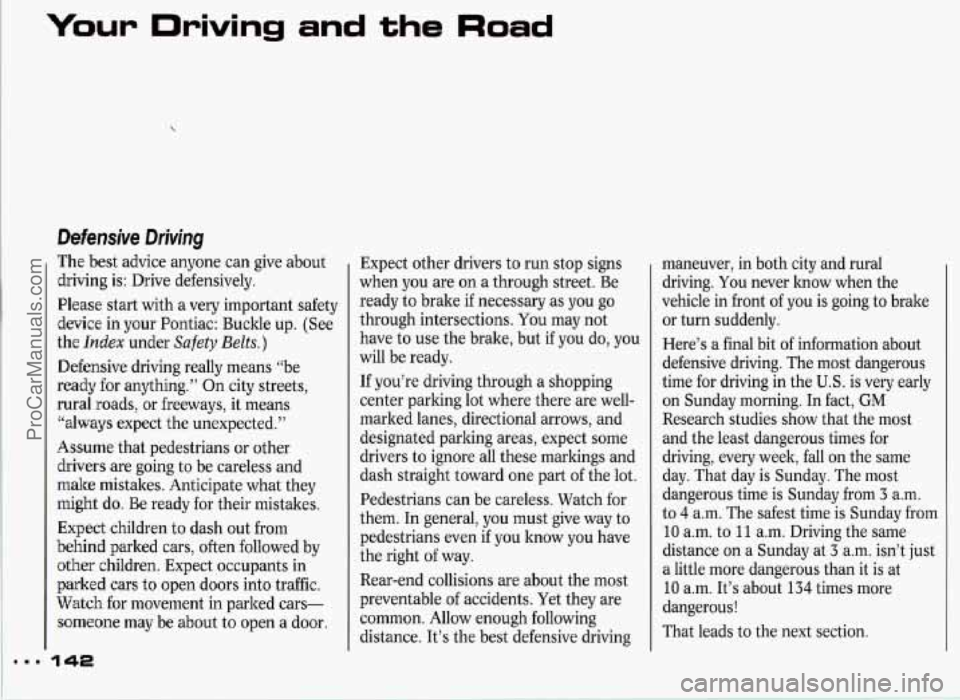
Yolur Driving and the Road
Defensive Driving
The best advice anyone can give about
driving is: Drive defensively.
Please start with a very important safety
device in your Pontiac: Buckle up. (See
the
Index under Safety Belts.)
Defensive driving really means “be
ready for anything.” On city streets,
rural roads, or freeways, it means
“always expect the unexpected.”
Assume that pedestrians or other
drivers are going to be careless and
make mistakes, Anticipate what they
might
do. Be ready for their mistakes.
Expect children
to dash out from
behind parked cars, often followed by
other children. Expect occupants in
parked cars to open doors into traffic.
Watch for movement in parked cars-
someone may be about to open a door.
142
Expect other drivers to run stop signs
when you are on a through street. Be
ready to brake if necessary as you go
through intersections.
You may not
have to use the brake, but
if you do, you
will be ready.
If you’re driving through a shopping
center parking lot where there are well-
marked lanes, directional arrows, and designated parking areas, expect some
drivers to ignore all these markings and
dash straight toward one part of the lot.
Pedestrians can be careless. Watch for
them. In general, you must give way to
pedestrians even if you know you have
the right of way.
Rear-end collisions are about the most
preventable of accidents. Yet they are
common. Allow enough following
distance. It’s the best defensive driving maneuver, in
both city
and rural
driving. You never know when the
vehicle in front of you is going to brake
or turn suddenly.
Here’s a final bit
of information about
defensive driving. The most dangerous
time for driving in the
U.S. is very early
on Sunday morning. In fact,
GM
Research studies show that the most
and the least dangerous times for
driving, every week, fall on the same
day. That day is Sunday. The most
dangerous time is Sunday from
3 a.m.
to 4 a.m. The safest time is Sunday from
10 a.m. to 11 a.m. Driving the same
distance on a Sunday at
3 a.m. isn’t just
a little more dangerous than it is at
10 a.m. It’s about 134 times more
dangerous!
That leads to the next section.
ProCarManuals.com
Page 144 of 338
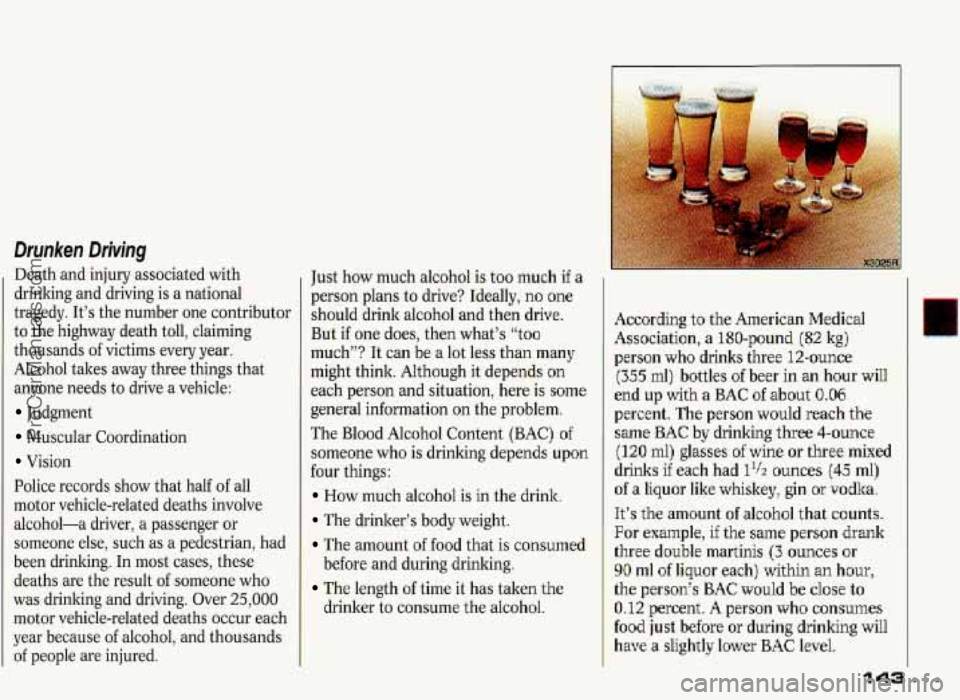
Drunken Driving
Death and injury associated with
drinking and driving is a national
tragedy. It’s the number one contributor
to the highway death toll, claiming
thousands of victims every
year.
Alcohol takes away three things that
anyone needs to drive a vehicle:
Judgment
Muscular Coordination
Vision
Police records show that half of all
motor vehicle-related deaths involve alcohol-a driver, a passenger or
someone else, such as a pedestrian, had
been drinking. In most cases, these
deaths are the result
of someone who
was drinking and driving. Over
25,000
motor vehicle-related deaths occur each
year because of alcohol, and thousands
of people are injured. Just
how much alcohol is too much
if a
~ person plans to drive? Ideally, no one
~ should drink alcohol and then drive.
But if one does, then what’s “too
much”? It can be
a lot less than many
might think. Although it depends on
each person and situation, here is
some
general information on the problem.
The Blood Alcohol Content (BAC)
of
someone who is drinking depends upon
four things:
How much alcohol is in the drink.
The drinker’s body weight.
The amount of food that is consumed
before and during drinlung.
The length of time it has taken the
drinker to consume the alcohol.
I
According to the American Medi’cal
Association,
a 180-pound [82 kg)
person who
drinks three 12-ounce
(355 mi) bottles of beer in an hour will
end up with a
BAC of about 0.06,
percent. The person would reach the
same BAC by drinking three 4-ounce
(120 ml) glasses of wine or three mixed
drinks
if each had ll/z ounces (45 ml)
of a liquor like whiskey, gin or vodka.
It’s the amount of alcohol that counts.
For example, if the same person drank
three double martinis (3 ounces or
90 rnl of liquor each) within an hour,
the person’s BAC would be close to
0.12 percent. A person who consumes
food just before or during drinking will
have a slightly lower BAC level.
ProCarManuals.com
Page 145 of 338
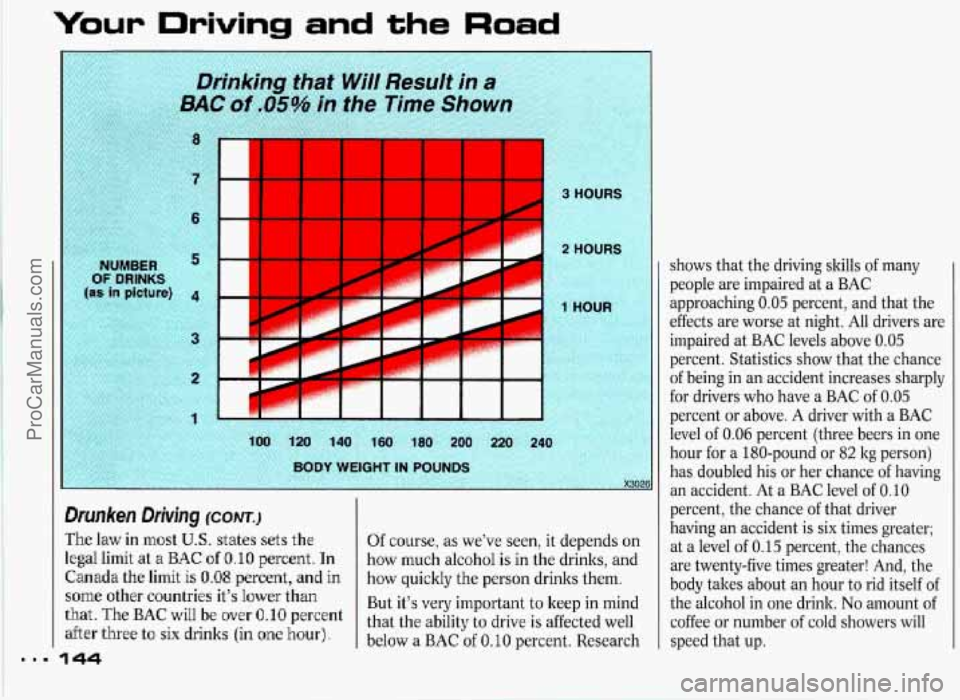
Your Driving and the Road
Drunken Driving (CONT.)
The law in most U.S. states sets the
legal limit at a BAC of 0.10 percent. In
Canada the limit is 0.08 percent, and in.
some other countries it’s lower than
that. The
BAC will be over 0.10 percent
after three to six drinks (in one hour),
144
Of course, as we’ve seen, it depends on
how much alcohol is in the drinks, and
how quickly the person drinks them.
But it’s very important
to keep in mind
that the ability to drive is affected well
below a BAC
of 0.10 percent. Research shows
that the driving skills of many
people are impaired at a BAC
approaching
0.05 percent, and that the
effects are worse at night. All drivers are
impaired at BAC levels above
0.05
percent. Statistics show that the chance
of being in an accident increases sharply
for drivers who have
a BAC of 0.05
percent or above. A driver with a BAC
level of
0.06 percent (three beers in one
hour for a 180-pound or
82 kg person)
has doubled his or her chance of having
an accident. At a BAC level
of 0.10
percent, the chance of that driver
having an accident is six times greater;
at a level
of 0.15 percent, the chances
are twenty-five times greater! And, the
body takes about an hour to rid itself of
the alcohol in one drink.
No amount of
coffee or number of cold showers will
speed that up.
ProCarManuals.com
Page 146 of 338
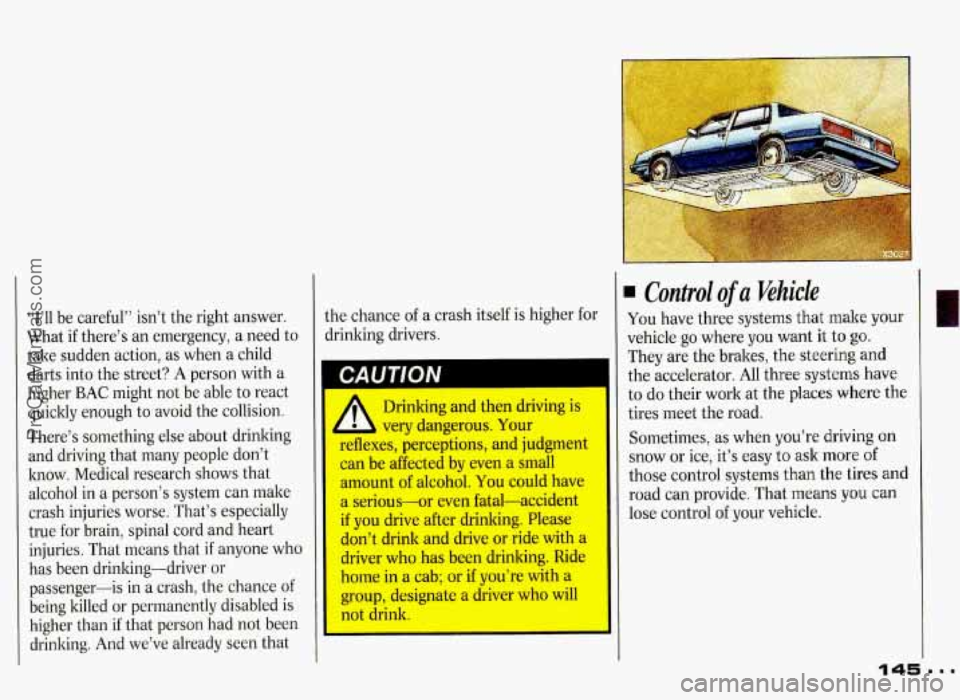
“I’ll be careful” isn’t the right answer.
What if there’s an emergency, a need to
take sudden action, as when
a child
darts into the street? A person with a
higher BAC might not be able to react
quickly enough to avoid the collision.
There’s something else about drinking
and driving that many people don’t
know. Medical research shows that
alcohol in a person’s system can make
crash injuries worse. That’s especially
true for brain, spinal cord and heart
injuries. That means that if anyone whc
has been drinking-driver or
passenger-is in a crash, the chance of
being killed or permanently disabled is
higher than if that person had not been
drinking. And we’ve already seen that the
chance of a crash itself is higher for
drinking drivers.
LAU I IUN
A Drinking and then driving is
reflexes, perceptions, and judgment
can be affected by even a small
amount of alcohol. You could have
a serious-or even fatal-accident
if you drive after drinking. Please
don’t drink and drive or ride with a
driver who has been drinking. Ride
home in
a cab; or if you’re with a
group, designate a driver who will
not drink.
3 very dangerous. Your
I
L
P
Control of a Vehicle
You have three systems that make your
vehicle
go where you want it to go.
They are the brakes, the steering and
the accelerator. All three systems have
to do their work at the places where the
tires meet the road.
Sometimes, as when you’re driving
on
snow or ice, it’s easy to ask more of
those control systems than the tires and
road can provide. That means
you can
lose control
of your vehicle.
1
ProCarManuals.com
Page 147 of 338
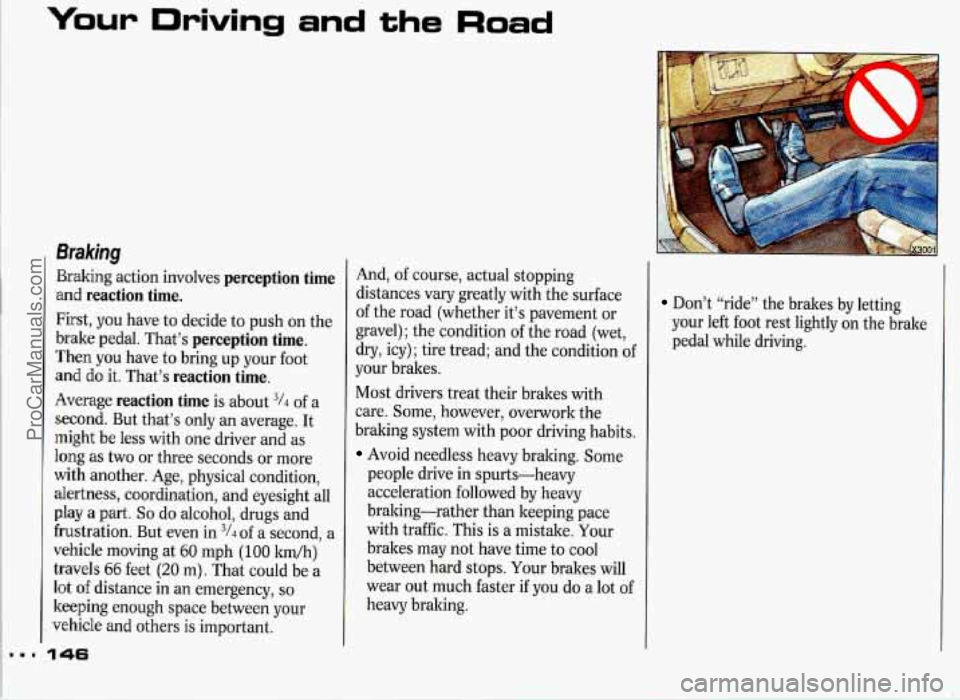
Your Driving and the Road
. .-
8raking
Braking action involves perception time
and reaction time.
First, you have to decide to push on the
brake pedal. That’s
perception time.
Then you have to bring up your foot
and do it. That’s
reaction time.
Average reaction time is about 3/4 of a
second. But that’s only an average.
It
might be less with one driver and as
long
as two or three seconds or more
with another. Age, physical condition,
alertness, coordination, and eyesight all
play a part.
So do alcohol, drugs and
frustration. But even in
3/4 of a second, a
vehicle moving at
60 mph (100 lun/h)
travels 66 feet (20 m). That could be a
lot
of distance in an emergency, so
keeping enough space between your
vehicle and others
is important.
146
~~ ~~ -
And, of course, actual stopping
distances vary greatly with the surface
of the road (whether it’s pavement or
gravel); the condition of the road (wet,
dry, icy); tire tread; and the condition of
your brakes.
Most drivers treat their brakes with
care. Some, however, overwork the
braking system with poor driving habits.
Avoid needless heavy braking. Some
people drive in spurts-heavy
acceleration followed by heavy
braking-rather than keeping pace
with traffic.
This is a mistake. Your
brakes may not have time to cool
between hard stops.
Your brakes will
wear out much faster if you do a lot of
heavy braking.
Don’t “ride” the brakes by letting
your left foot rest lightly on the brake
pedal while driving.
ProCarManuals.com
Page 148 of 338
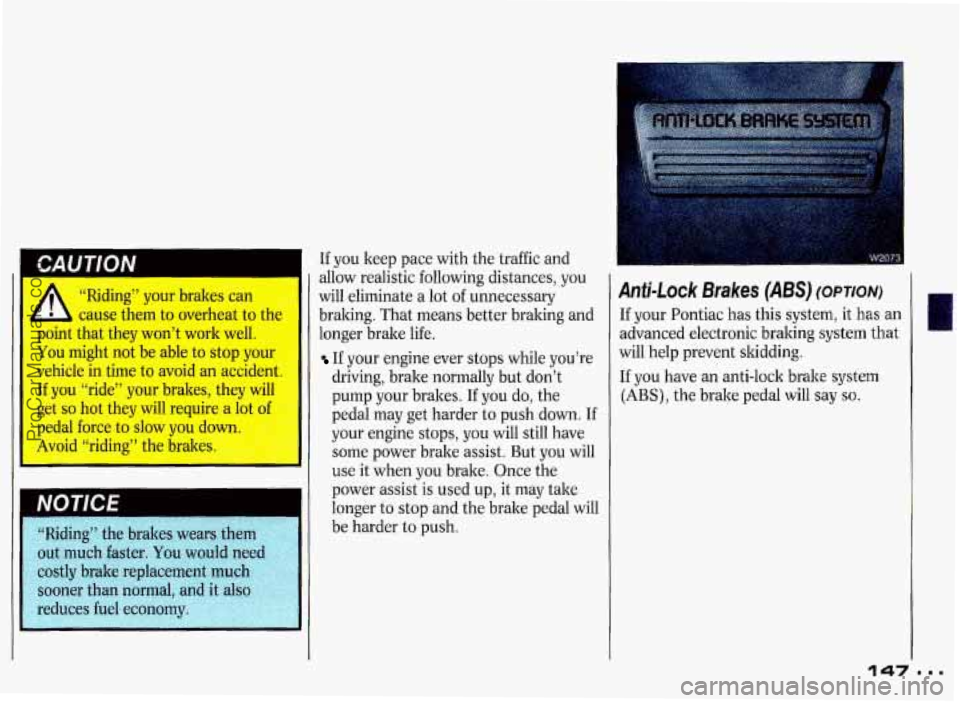
‘Riding” your brakes can
:ause them to overheat to t
point that they won’t work well.
You might not be able to stop your
vehicle in time to avoid an accident.
If you “ride” your brakes, they will
get
so hot they will require a lot of
pedal force to slow you
&--
Avoid “riding” the brake-. 3
I’
rs wears them 1 ”)- 2.’;
out much faster. You would need 253
costly brake replacement much 35
sooner than normal, and it also ?$:
.,,&
,,.7.. d:$
/P ,=;.;>,:
If you keep pace with the traffic and
allow realistic following distances, you
will eliminate a lot of unnecessary
braking. That means better braking and
longer brake life.
If your engine ever stops while you’re
driving, brake normally but don’t
pump your brakes. If you do, the
pedal may get harder to push down. If
your engine stops, you will still have
some power brake assist. But you will
use it when you brake. Once the
power assist is used up, it may take
longer to stop and the brake pedal will
be harder to push.
Anti-Lock Brakes (ABS) (OPTION)
If your Pontiac has this system, it has an
advanced electronic braking system
that
will help prevent skidding.
If you have an anti-lock brake system
(ABS), the brake pedal will say so.
ProCarManuals.com
Page 149 of 338
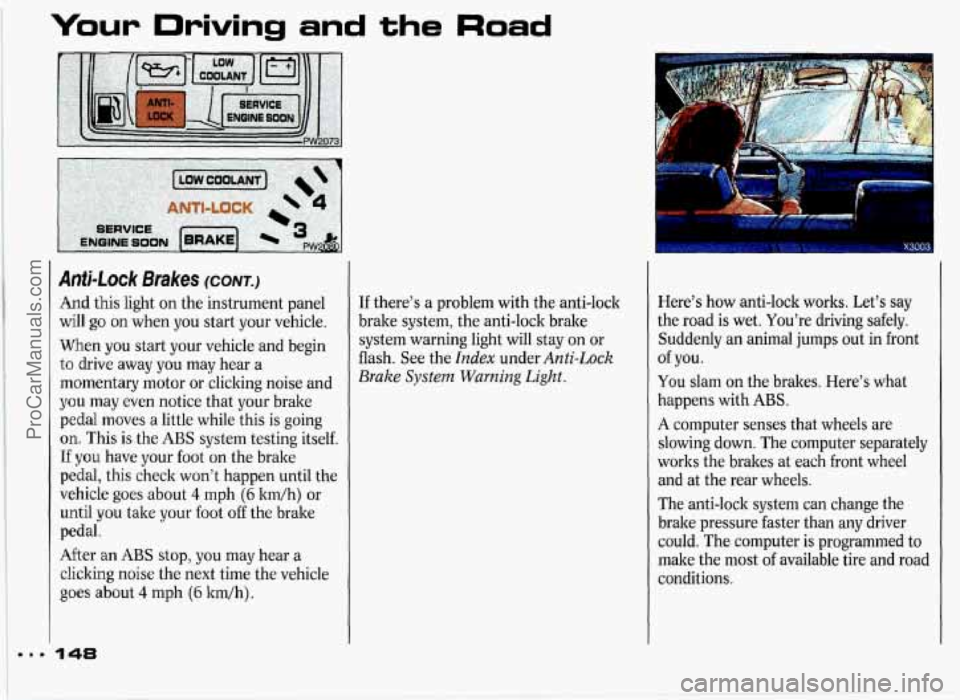
ma.
Your Driving and the Road
Anti-lock Brakes (CONT.)
And this light on the instrument panel
will
go on when you start your vehicle.
When you start your vehicle and begin
to drive away you may hear a
momentary motor or clicking noise and
you may even notice that your brake
pedal moves a little while this is going
on. This is the ABS system testing itself.
If you have your foot on the brake
pedal, this check won't happen until the
vehicle goes about
4 mph (6 ltm/h) or
until you take your foot off the brake
pedal.
After
an ABS stop, you may hear a
clicking noise the next time the vehicle
goes about 4 mph (6 ltdh).
148
If there's a problem with the anti-lock
brake system, the anti-lock brake
system warning light will stay on or
flash. See the
Index under Anti-Lock
Brake
System Warning Light.
Here's how anti-lock works. Let's say
the road is wet. You're driving safely.
Suddenly an animal jumps out in front
You slam on the brakes. Here's what
happens with
ABS.
A computer senses that wheels are
slowing down. The computer separately
works the brakes at each front wheel
and at the rear wheels.
The anti-lock system can change the
brake pressure faster than any driver
could. The computer is programmed to
make the most
of available tire and road
conditions.
of you.
ProCarManuals.com
Page 150 of 338
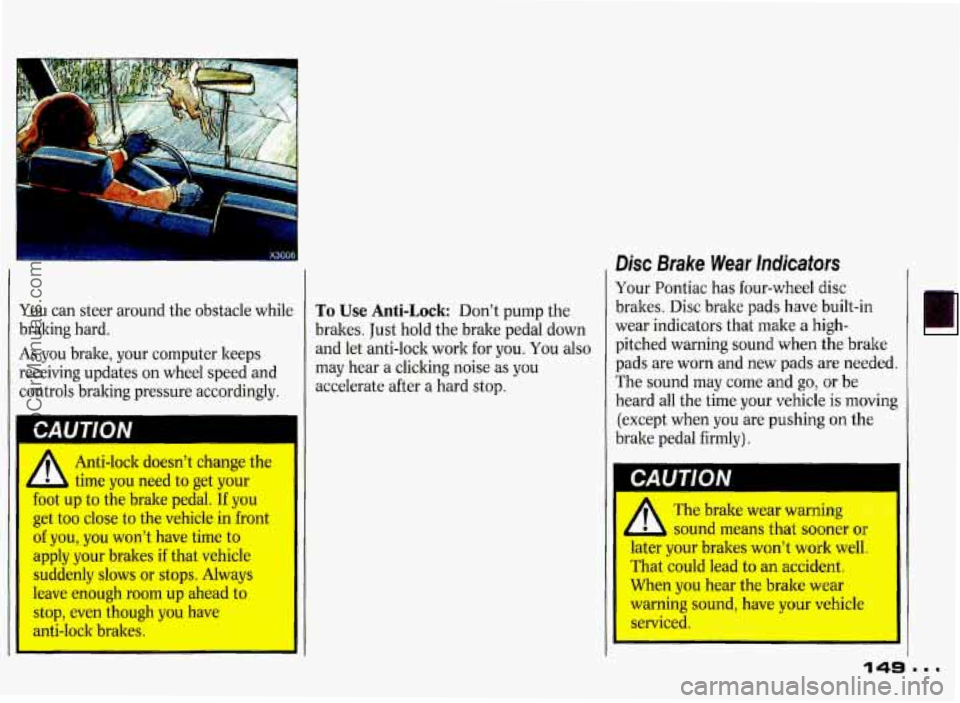
I
You can steer around the obstacle while To Use Anti-Lock Don’t pump the
braking hard.
brakes. Just hold the brake pedal down
As you brake, your computer keeps and
let anti-lock work for you. You also
receiving updates on wheel speed and
may hear a cliclting noise as you
controls braking pressure accordingly. accelerate
after a hard stop.
Anti-lock doesn’t change the
time you need to get your
foot up to the brake pedal. If you
get too close to the vehicle in front
of you,
you won’t have time to
apply your braltes
if that vehicle
suddenly slows or stops. Always
leave enough
room up ahead to
stop, even though you have
anti-lock brakes.
Disc Brake Wear Indicators
Your Pontiac has four-wheel disc
braltes. Disc brake pads have built-in
wear indicators that make a high-
pitched warning sound when the brake
pads are worn and new pads are needed.
The sound may come and go,
or be
heard all the time your vehicle
is moving
(except when you are pushing on the
brake pedal firmly).
I
A The brake wear warnin&
sound means that sooner
or
later your brakes won’t work well,
That could lead
to an accident.
When you hear the brake wear
warning sound, have
your vehicle
serviced.
ProCarManuals.com